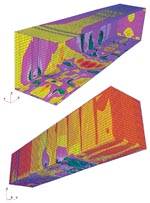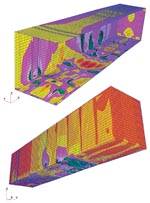Commercial ground transport: A very present opportunity
Industry consultant Bob Lacovara, principal at Convergent Composites (Perkasie, Pa.) and the former technical director of the American Composites Manufacturers Assn., argues for an automotive sector composites-for-metal conversion harvest in the ripe-for-picking Class 8 truck category.
The business model for innovation is driven by market needs. Where there is a need, an opportunity is awaiting discovery with the development of differentiating or disruptive technologies. At this juncture, the transportation sector is primed for this kind of evolutionary leap, and composites could propel that next round of advancement. In fact, the business model can be derived from the laws of physics.
Ultimately, it takes money to power vehicles, money in terms of the energy conversion that is required to accelerate mass and overcome air resistance. The energy conversion for city driving is dominated by Newton’s Second Law: The acceleration of a body is directly proportional to the net force on it and inversely proportional to its mass. This is expressed as a=F/m. Of the available fuel energy, 84 percent is consumed by friction, heat loss, drivetrain and other losses, and another 15 percent is required for standby acceleration of the mass. Only 1 percent of the expended energy actually moves the passenger. We need to revisit an important question: Is the purpose to move a 3,000-lb vehicle or to transport the occupants?
The traditional approach to reducing vehicle weight is to make the vehicle smaller. When the materials and production methods don’t change, the only path to weight reduction is to use less material. That translates into the reduced surface area of a smaller vehicle. In Europe the cultural and economic barriers to ownership of small cars have been breached, and today, small is the norm. That is not the case in North America, where a combination of geography, use patterns and the cultural overlay still make a small car look like a deprivation.
The latest buzzword in the automotive advancement lexicon is “lightweighting,” as in reducing vehicle mass. Herein, composites offer the opportunity for automotive manufacturers to decouple size from weight.
The auto manufacturers are listening … sort of. They are interested but have trouble seeing past their established technologies: metal stamping and welding robots. Ultimately, Newton will prevail because we can’t escape a=F/m. If the opportunity is to be realized, however, the composites industry has to step up to the plate in two areas: (1) we need less-expensive carbon fiber if we expect to compete with steel on a specific-strength basis, and (2) we need to develop faster processing methods than are currently available. The opportunity for this disruptive advancement lies before those who dare to address the laws of physics.
In the case of highway driving, the equation shifts, because energy conversion is dominated by aerodynamics. The resistance of a body moving through the fluid environment of air is known as the drag coefficient (Cd). At highway speeds, an energy reserve of about 14 percent is required to overcome aero-drag resistance in cars, and large trucks can consume as much as 20 percent of expended energy in the task of displacing air.
Here is something to consider: EPA fuel mileage requirements and CAFE averages are calculated for vehicles moving at a speed of 55 mph. This benchmark speed, however, is a throwback to the Nixon Administration’s one-time national speed limit. Today’s posted interstate speed limits are 65, 75 and, sometimes, 80 mph. And in reality, 69 percent of traffic exceeds a posted 55-mph limit, 54 percent exceeds a 65-mph posting and 46 percent travels faster than the 75 mph limits. The fact is that drivers routinely travel at 75 to 85 mph on our national highways. At 75 mph, fuel usage is about 23 percent lower than the EPA benchmark. Government and manufacturer fuel consumption calculations revolve around 55 mph, but we should be building vehicles that are aero-tuned for a more realistic 75 mph.
In the quest to improve vehicle aerodynamic efficiency, Class 8 tractor-trailers are the low-hanging fruit. Although passenger-vehicle improvements will require as yet undeveloped advancements in material costs and production methods, all of the technology necessary to dramatically improve truck efficiency is already in place and readily available.
Today’s trucks are a variation on a theme established more than 100 years ago. The morphology of truck design stems from the horse and wagon and the early 20th Century adaptation of the internal combustion engine to self-powered vehicles. These evolved characteristics include a large, flat radiator; accessories that protrude into the airstream; and a side-by-side seating configuration in the cab.
These design features were not an issue when most traffic moved at 35 mph. They were, maybe, a small consideration when 55 mph was the highway standard. But at 75-mph highway speeds, the aerodynamic drag loss is very significant.
Old-style, squared-off trucks with mirrors, exhaust stacks and myriad other accessories in the airstream have a Cd in the area of 0.87+. The latest models feature some modest aerodynamic restyling that has reduced drag loss to somewhere near 0.75, depending on the trailer configuration. With that in mind, here are the big-picture statistics:
• The U.S. fleet has 2.2 million Class 8 trucks in service.
• Class 8 trucks drive 60 billion highway miles a year.
• At an average of 6.1 mpg, they consume more than 9.8 billion gal
of diesel fuel per year.
• The annual fuel cost is more than $50 billion (USD).
Now consider this: If the Cd could be reduced to 0.48, it would result in an increase in fuel mileage from 6.1 mpg to 8.6 mpg. The savings in fuel costs would be $12 billion per year, added directly to the trucking industry’s bottom line. And that translates into substantially less imported petroleum as well.
So how do we create a 0.48 Cd truck? First, we redesign the cab for single or tandem, rather than side-by-side, seating. The vast majority of trucks operate with only one driver onboard, offering the opportunity to reduce the current frontal volume of the cab. Next, we eliminate the large vertical radiator that produces a high drag area. There are alternative cooling configurations that can minimize frontal openings. Then we eliminate all the exterior bling hanging off the cab. Rear-view video, proximity radar and synthetic vision systems are currently available as off-the-shelf automotive technologies, and the cost of these systems is well within the scope of the savings yield. Finally, we incorporate the necessary gap and air-dam sealing into the trailer to reduce underbody airflow.
All of the technology necessary to build a 0.48 cD Class 8 tractor-trailer rig is readily available, and composites can play a major role in this disruptive transformation. Unlike with automotive production, carbon fiber-reinforced composites are not required for heavy truck advancement. Glass fiber-reinforced composites can effectively produce the necessary aero-shapes. Additionally, currently available molding methods are in sync with truck production volumes.
Technically, then, the stage is set, and composites can fill the redesign gap right now. But practically, there remains a cultural issue within the trucking community. At odds with the idea of saving $12 billion a year with aerodynamic improvements is the commercial ground transport industry’s general perception of what a truck should look like. If we are to see technology flow successfully into disruptive advancement, we must collectively overcome this traditional view by actively promoting this new vision within the community of vehicle manufacturers and end-users.
In the end, Newton and fluid dynamics will win. The opportunity for composites professionals is to hasten the day.
Related Content
TPI manufactures all-composite Kenworth SuperTruck 2 cab
Class 8 diesel truck, now with a 20% lighter cab, achieves 136% freight efficiency improvement.
Read MoreSMC composites progress BinC solar electric vehicles
In an interview with one of Aptera’s co-founders, CW sheds light on the inspiration behind the crowd-funded solar electric vehicle, its body in carbon (BinC) and how composite materials are playing a role in its design.
Read MoreThermoplastic composites: Cracking the horizontal body panel nut
Versatile sandwich panel technology solves decades-long exterior automotive challenge.
Read MoreMcLaren celebrates 10 years of the McLaren P1 hybrid hypercar
Lightweight carbon fiber construction, Formula 1-inspired aerodynamics and high-performance hybrid powertrain technologies hallmark this hybrid vehicle, serve as a springboard for new race cars.
Read MoreRead Next
Fuel Economy Drives Big Rig Composites
A variety of materials and processing methods are lightweighting and economizing trucks and trailers in the commercial freight arena.
Read MoreVIDEO: High-volume processing for fiberglass components
Cannon Ergos, a company specializing in high-ton presses and equipment for composites fabrication and plastics processing, displayed automotive and industrial components at CAMX 2024.
Read More“Structured air” TPS safeguards composite structures
Powered by an 85% air/15% pure polyimide aerogel, Blueshift’s novel material system protects structures during transient thermal events from -200°C to beyond 2400°C for rockets, battery boxes and more.
Read More


























